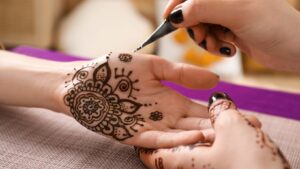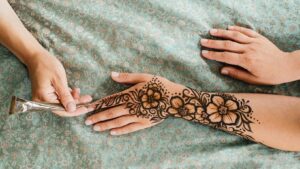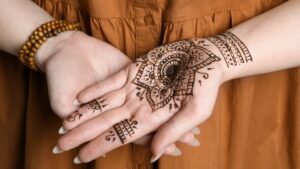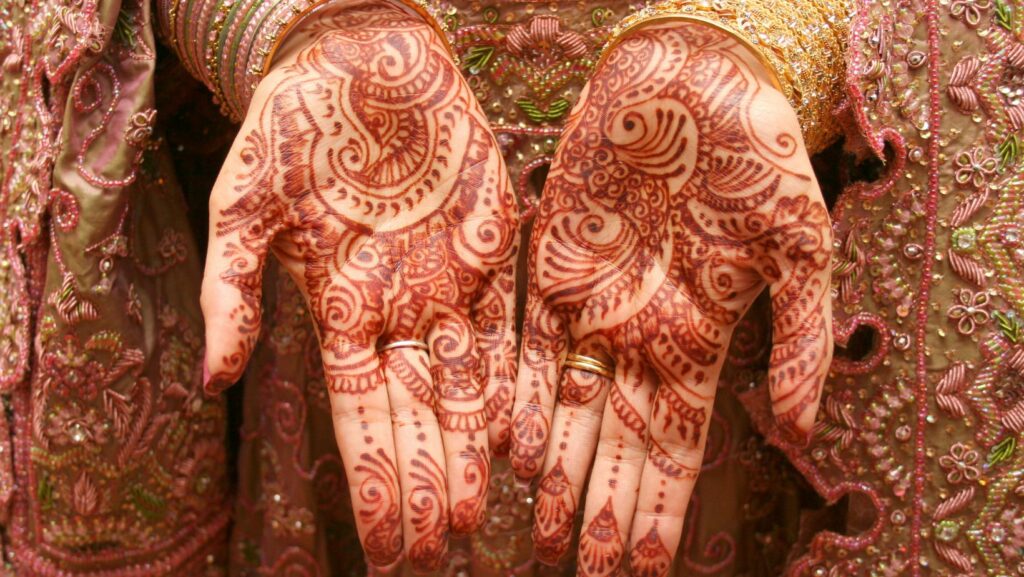In the world of body art, Arabic Mehndi holds a place of prominence. It’s not just an adornment, but a cultural symbol that has been passed down through generations. With its intricate patterns and stunning designs, Arabic Mehndi captivates hearts and celebrates beauty.
Arabic:halhzhy_rjw= Mehndi

Diving deeper into Arabic Mehndi, one discovers its elegance lies in simplicity and spacing. Unlike other styles, Arabic Mehndi focuses on the backbone, a floral pattern that’s frequently recurring and includes vines. Isolated designs, dotted highlights, and sharp edges differentiate it from its counterparts.
Arabic Mehndi has an open concept. In this distinct attribute, large areas of skin are visible, putting more emphasis on the design’s beauty. Ambiguity doesn’t encompass the design; each twist and turn carries meaning. Floral patterns represent joy and happiness, while peacock designs exemplify passion and love.
Mastery of Arabic Mehndi demands skill and practice. Precision is the essence of application as the consistency of the paste and speed affect the final look. The technique-personified elegance gives Arabic Mehndi its unique appeal, expressing tradition in each stroke. Donned by women globally, Arabic Mehndi transcends cultural boundaries, as it’s a testament to design sophistication and artistry.
Popular Arabic Mehndi Designs
Across cultures and celebrations, Arabic Mehndi designs shine as markers of skilled art and tradition. Here’s a breakdown of some popular styles:

- Paisley Perfection: This intricate design features teardrop-shaped motifs, commonly known as Paisleys, often embellished with other symbols. For instance, vine trails, dot accents, and leaf sketches frequently surround these elite motifs.
- Flower Power: Floral designs remain a crucial component of Arabic Mehndi. From multi-petalled rosettes to minimal daises, blossoms add elegance and femininity to the piece. Often, fine lines and shading enhance these floral motifs.
- Diagonal Drama: Uniquely Arabic, a diagonal trail running across the palm highlights the skin’s negative space. The pattern often extends to the forearm and sometimes even the upper arm, culminating in a stunning design.
- Checks and Tiles: Like an intricate tapestry, checked and tiled patterns infuse geometric charm into Arabic Mehndi. Combined with other motifs, these design grids deliver an aesthetically pleasing look.
- Open Vines: The expanse of open vines remains a true representation of Arabic style. Swirling vines mingled with botanical accents deliver a free-flowing design with an unmatched grace.
Applying Arabic Mehndi
After choosing an Arabic Mehndi design, the application process comes next. It’s typically done with a cone applicator filled with henna paste. Brush strokes, akin to painting, create the desired patterns on the skin.
Here are four key steps in applying Arabic Mehndi:
- Preparation of Skin: Before the application, the skin must be clean, dry, and free of oils or lotions. This ensures optimal henna paste adherence. Applicators often use a mild soap and warm water or a suitable cleanser for this step.
- Applying the Paste: The henna paste gets applied via the cone applicator. Care and precision matter most here. More intricate designs, such as floral motifs and geometric patterns, might demand significant time and focus for proper execution.
- Drying of the Mehndi: Post-application, the Mehndi needs time to dry, usually three to six hours, depending on the design intricacy and henna paste’s composition. Avoid touching anything during this period as it might ruin the design.
- Removal of the Paste: After the drying period, the henna paste gets gently scraped off from the skin. The colour darkens over the next 48 hours, producing a beautiful reddish-brown hue.
Care and Maintenance

Arabic Mehndi’s allure lies not only in its intricate patterns but also in the patience and care that go into its application and maintenance. It’s a testament to the artistry and tradition that’s been passed down through generations.
The elegance of Paisley motifs, floral patterns, diagonal trails, geometric checks, and open vines each add a unique touch to the wearer’s hands.
But it’s the meticulous application process – from skin preparation to paste removal – that truly brings out the enduring charm of this ancient art form. Remember, the beauty of Arabic Mehndi isn’t just about the design; it’s the journey of creating and maintaining it. So, whether you’re a mehndi enthusiast or a first-timer, embrace the process and enjoy the stunning results that come with it.



